-
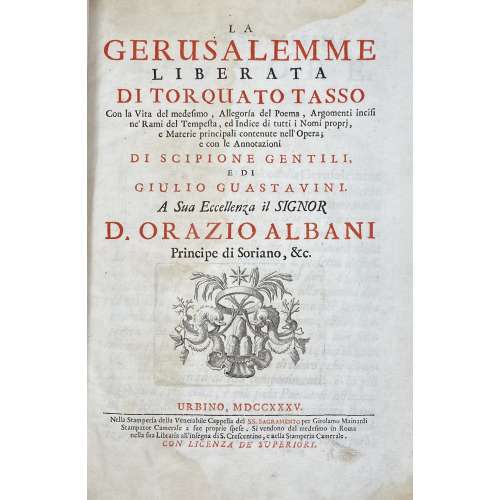 Title page (in red and black): LA | GERUSALEMME | LIBERATA | DI TORQUATO TASSO | Con la Vita del medesimo , Allegoria del Poema , Argomenti incisi | ne’Rami del Tempesta , ed Indice di tutti i Nomi proprj , | e Materie principali contenute nell’Opera ; | e con le Annotazioni | DI SCIPIONE GENTILI | E DI | GIULIO GUASTAVINI. | A Sua Eccellenza il SIGNOR | D. ORAZIO ALBANI | Principe di Soriano, &c. | {printer’s device} | URBINO, MDCCXXXV. | — | Nella Stamperia della Venerabile Cappella del SS. SAGRAMENTO per Girolamo Mainardi | Stampator Camerale a sue proprie spese . Si vendono dal medesimo in Roma | nella sua Libraria all’insegna di S. Crescentino, e nella Stamperia Camerale | CON LICENZA DE SUPERIORI. || Half-title: Title page: IL | GOFFREDO | OVVERO | LA GERUSALEMME | LIBERATA | DI | TORQUATO TASSO. || Collation: 4to; [2] blank leaves, [1] – h.t. / blank, [1] – t.p. / blank, [1] – dedication signed *2, [2] – vita, 1st signed *3, [2] – allegoria, [3] – indice, first two signed ** and **2, respectively, [1] – frontispiece to Canto Primo —> total 13 prelims; π13 (incl. 2 blanks), A-Z4 Aa-Bb4 Cc6 Dd-Qq4, χ1 (blank); 20 engraved frontispieces, one headpiece and initials, some historiated. Frontis. to Cantos II-XX incl. in collation and pagination; the number of leaves from A1 to Qq4 = 158; pagination: 1-316. The total number of leaves incl. prelims and blanks = 172. Note: three first leaves in the Cc quire of six leaves are signed; all other four-leaf quires only have the first two first leaves signed. Frontispiece to Canto Quarto cut down and laid down on D2v (as in Christie’s copy sold on 6 Jun 2010 – Live Auction 5475 – Fine Printed Books and Manuscripts, lot 168, price realized GBP 600). Illustrations: Frontispiece to Canto Primo signed “Arnoldo van Westerhout formis Roma”. Headpiece to Canto Primo signed “Eq. Petrus Leo Ghezius Inu. et. delin. — Frãn. Aquila incid.” Other plates unsigned but all attributed to Westerhout after Antonio Tempesta; Numeration of frontispieces in roman numbers, IIII for VI, VIIII for IX, XIIII for XIV, inverted numbers XVII, XVIII, and XIX, respectively: IIVX, IIIVX, and IIIIVX. Binding: 35 x 24 cm, 34 x 23 cm leaves, contemporary calf, rebacked retaining original spine, verso front flyleaf stamped “RESTORED BY MACDONALD CO. | NORWALK. CONN. Marbled endpapers, all edges red. Speckled calf, gilt triple-fillet borders, with remnants of blind-stamped and gilt design to an upper inside corner, spine with raised bands, gilt acorn tooling in compartments, later crimson label with gilt lettering. Damp staining to inside edges affecting all leaves. The Robin Collection bookplate to front pastedown. Provenance: The Robin Collection. Contributors: Torquato Tasso (Italian, 1544 –1595) – author. Scipione Gentili [Scipio Gentilis] (Italian, 1563 – 1616) Giulio Guastavini (Italian, fl. 16th century) Antonio Tempesta [Tempestino] (Italian, 1555 – 1630) – artist. Arnold [Arnoldo] van Westerhout (Flemish, 1651 – 1725) – artist, engraver. Pier Leone Ghezzi (Italian, 1674 – 1755) – artist. Francesco Faraone Aquila (Italian, c. 1676 – c. 1740) – engraver. Girolamo Mainardi (Italian, c. 1679 circa – 1763) – printer, publisher. Orazio Albani (Italian, 1576 – 1653) – dedicatee.
Title page (in red and black): LA | GERUSALEMME | LIBERATA | DI TORQUATO TASSO | Con la Vita del medesimo , Allegoria del Poema , Argomenti incisi | ne’Rami del Tempesta , ed Indice di tutti i Nomi proprj , | e Materie principali contenute nell’Opera ; | e con le Annotazioni | DI SCIPIONE GENTILI | E DI | GIULIO GUASTAVINI. | A Sua Eccellenza il SIGNOR | D. ORAZIO ALBANI | Principe di Soriano, &c. | {printer’s device} | URBINO, MDCCXXXV. | — | Nella Stamperia della Venerabile Cappella del SS. SAGRAMENTO per Girolamo Mainardi | Stampator Camerale a sue proprie spese . Si vendono dal medesimo in Roma | nella sua Libraria all’insegna di S. Crescentino, e nella Stamperia Camerale | CON LICENZA DE SUPERIORI. || Half-title: Title page: IL | GOFFREDO | OVVERO | LA GERUSALEMME | LIBERATA | DI | TORQUATO TASSO. || Collation: 4to; [2] blank leaves, [1] – h.t. / blank, [1] – t.p. / blank, [1] – dedication signed *2, [2] – vita, 1st signed *3, [2] – allegoria, [3] – indice, first two signed ** and **2, respectively, [1] – frontispiece to Canto Primo —> total 13 prelims; π13 (incl. 2 blanks), A-Z4 Aa-Bb4 Cc6 Dd-Qq4, χ1 (blank); 20 engraved frontispieces, one headpiece and initials, some historiated. Frontis. to Cantos II-XX incl. in collation and pagination; the number of leaves from A1 to Qq4 = 158; pagination: 1-316. The total number of leaves incl. prelims and blanks = 172. Note: three first leaves in the Cc quire of six leaves are signed; all other four-leaf quires only have the first two first leaves signed. Frontispiece to Canto Quarto cut down and laid down on D2v (as in Christie’s copy sold on 6 Jun 2010 – Live Auction 5475 – Fine Printed Books and Manuscripts, lot 168, price realized GBP 600). Illustrations: Frontispiece to Canto Primo signed “Arnoldo van Westerhout formis Roma”. Headpiece to Canto Primo signed “Eq. Petrus Leo Ghezius Inu. et. delin. — Frãn. Aquila incid.” Other plates unsigned but all attributed to Westerhout after Antonio Tempesta; Numeration of frontispieces in roman numbers, IIII for VI, VIIII for IX, XIIII for XIV, inverted numbers XVII, XVIII, and XIX, respectively: IIVX, IIIVX, and IIIIVX. Binding: 35 x 24 cm, 34 x 23 cm leaves, contemporary calf, rebacked retaining original spine, verso front flyleaf stamped “RESTORED BY MACDONALD CO. | NORWALK. CONN. Marbled endpapers, all edges red. Speckled calf, gilt triple-fillet borders, with remnants of blind-stamped and gilt design to an upper inside corner, spine with raised bands, gilt acorn tooling in compartments, later crimson label with gilt lettering. Damp staining to inside edges affecting all leaves. The Robin Collection bookplate to front pastedown. Provenance: The Robin Collection. Contributors: Torquato Tasso (Italian, 1544 –1595) – author. Scipione Gentili [Scipio Gentilis] (Italian, 1563 – 1616) Giulio Guastavini (Italian, fl. 16th century) Antonio Tempesta [Tempestino] (Italian, 1555 – 1630) – artist. Arnold [Arnoldo] van Westerhout (Flemish, 1651 – 1725) – artist, engraver. Pier Leone Ghezzi (Italian, 1674 – 1755) – artist. Francesco Faraone Aquila (Italian, c. 1676 – c. 1740) – engraver. Girolamo Mainardi (Italian, c. 1679 circa – 1763) – printer, publisher. Orazio Albani (Italian, 1576 – 1653) – dedicatee. -
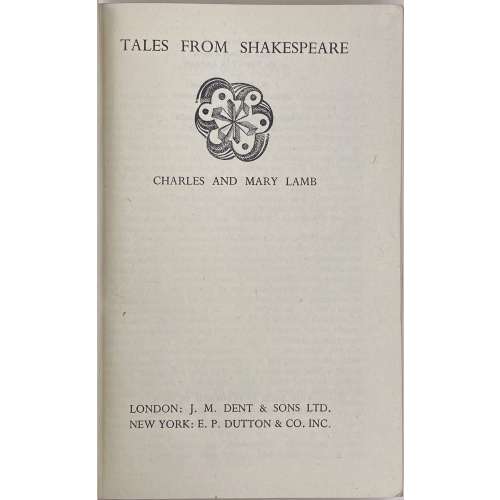 Description: 17.4 x 11 cm, blue publisher’s cloth, blind device to front board, gilt lettering to spine, no DJ, pink abstract diaper endpapers, owner’s ink inscription to ffep, dated June 28, 1945. Serial t.p.: Everyman, I will go with thee, and be thy guide, | In thy most need to go by the side. | — | EVERYMAN'S LIBRARY | EDITED BY ERNEST RHYS | No. 8 | FOR YOUNG PEOPLE | TALES FROM SHAKESPEARE | BY CHARLES AND MARY LAMB | ILLUSTRATIONS BY ARTHUR | RACKHAM || Title-page: TALES FROM SHAKESPEARE | {device} | CHARLES AND MARY LAMB | LONDON: J. M. DENT & SONS LTD. | NEW YORK: E. P. DUTTON & CO. INC. || T.p verso: All rights reserved | Made in Great Britain | at The Temple Press Letchworth | for | J. M. Dent & Sons Ltd. | Aldine House Bedford St. London | First published 1807 | First published in this edition 1906 | Last reprint (reset) 1944 | [blank] | THIS BOOK IS PRODUCED IN COM- | PLETE CONFORMITY WITH THE | AUTHORIZED ECONOMY STANDARDS || Collation: 16mo; [A]-K16; total 160 leaves, 9 full-page illustrations after Arthur Rackham, within collation (text on the other side). Pagination: [i-iv] v-viii, 1-312, total 320 pages, ils. Contributors: William Shakespeare (English, 1564 – 1616) Mary Ann Lamb (British, 1764 – 1847) – author. Charles Lamb (British, 1775 – 1834) – author. Ernest Percival Rhys (British, 1859 – 1946) – editor. Arthur Rackham (British, 1867 – 1939) – artist.
Description: 17.4 x 11 cm, blue publisher’s cloth, blind device to front board, gilt lettering to spine, no DJ, pink abstract diaper endpapers, owner’s ink inscription to ffep, dated June 28, 1945. Serial t.p.: Everyman, I will go with thee, and be thy guide, | In thy most need to go by the side. | — | EVERYMAN'S LIBRARY | EDITED BY ERNEST RHYS | No. 8 | FOR YOUNG PEOPLE | TALES FROM SHAKESPEARE | BY CHARLES AND MARY LAMB | ILLUSTRATIONS BY ARTHUR | RACKHAM || Title-page: TALES FROM SHAKESPEARE | {device} | CHARLES AND MARY LAMB | LONDON: J. M. DENT & SONS LTD. | NEW YORK: E. P. DUTTON & CO. INC. || T.p verso: All rights reserved | Made in Great Britain | at The Temple Press Letchworth | for | J. M. Dent & Sons Ltd. | Aldine House Bedford St. London | First published 1807 | First published in this edition 1906 | Last reprint (reset) 1944 | [blank] | THIS BOOK IS PRODUCED IN COM- | PLETE CONFORMITY WITH THE | AUTHORIZED ECONOMY STANDARDS || Collation: 16mo; [A]-K16; total 160 leaves, 9 full-page illustrations after Arthur Rackham, within collation (text on the other side). Pagination: [i-iv] v-viii, 1-312, total 320 pages, ils. Contributors: William Shakespeare (English, 1564 – 1616) Mary Ann Lamb (British, 1764 – 1847) – author. Charles Lamb (British, 1775 – 1834) – author. Ernest Percival Rhys (British, 1859 – 1946) – editor. Arthur Rackham (British, 1867 – 1939) – artist.Temple Press, Letchworth, England – printer.
Joseph Malaby Dent (British, 1849 – 1926) – publisher. Note: “On the writing desk were two books – identical copies of Lamb’s Tales From Shakespeare. […] — Why did you choose Lamb? — It was the only book I could find in duplicate except Uncle Tom’s Cabin…” Graham Greene. Our Man in Havana. -
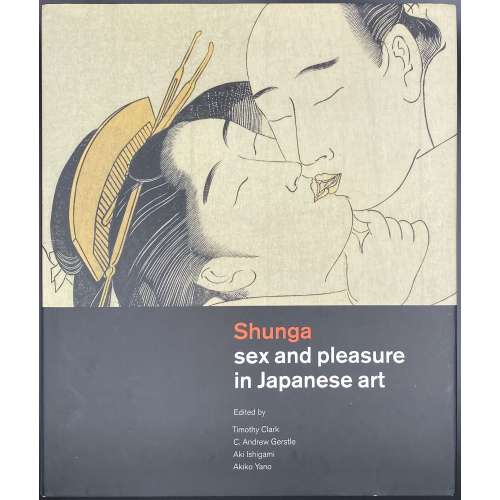 Hardcover volume, 29.6 x 25 x 4 cm, in red cloth with black lettering to spine, in pictorial dust jacket, profusely illustrated in colour; pp.: [1-6] 7-536, total 268 leaves and 2 folding plates extraneous to collation. Title-page: {Hotei's device} Hotei Publishing | Shunga | sex and pleasure in Japanese art | Edited by | Timothy Clark | C. Andrew Gerstle | Aki Ishigami | Akiki Yano || Contents: The Cultural Historical Significance and Importance of Japanese Shunga / Kobayashi Tadashi. Introduction: What Was Shunga? / C. Andrew Gerstle; Who Were the Audiences for Shunga? / Hayakawa Monta. (1) Early Shunga before 1765: Shunga Paintings before the `Floating World' / Akiko Yano; Chinese Chunhua and Japanese Shunga / Ishigami Aki; Shunga and the Rise of Print Culture / Asano Shugo. (2) Masterpieces of Shunga 1765-1850: The Essence of Ukiyo-e Shunga / Kobayashi Tadashi; Erotic Books as Luxury Goods / Ellis Tinios; Listening to the Voices in Shunga / Hayakawa Monta; The Tale of Genji in Shunga / Sato Satoru. (3) Censorship: Timeline of Censorship; Shunga and Censorship in the Edo Period (1600-1868) / Jennifer Preston; Graph of approximate output of shunga print series and books; The Censorship of Shunga in the Modern Era / Ishigami Aki; Shunga Studies in the Showa Era (1926-89) / Shirakura Yoshihiko. (4) Contexts for Shunga: Traditional Uses of Shunga / Yamamoto Yukari; The Distribution and Circulation of Erotic Prints and Books in the Edo Period Laura Moretti; Shunga and Parody / C. Andrew Gerstle; Popular Cults of Sex Organs in Japan / Suzuki Kenko; Grotesque Shunga / Ishigami Aki; Violence in Shunga / Higuchi Kazutaka; Foreign Connections in Shunga / Timon Screech; Children in Shunga / Akiko Yano; Shunga and the Floating World / Matsuba Ryoko. (5) Shunga in the Meiji Era: Erotic Art of the Meiji Era (1868-1912) / Rosina Buckland; The Modern West's Discovery of Shunga / Ricard Bru. Published to accompany the exhibition Shunga: sex and pleasure in Japanese art at the British Museum from 3 October 2013 to 5 January 2014. Abstract: This catalogue aims to answer some key questions about what is shunga and why it was produced. In particular, the social and cultural contexts for sex art in Japan are explored. Erotic Japanese art was heavily suppressed in Japan from the 1870s onwards as part of a process of cultural 'modernisation' that imported many contemporary western moral values. Only in the last twenty years or so has it been possible to publish unexpurgated examples in Japan and this landmark book places erotic Japanese art in its historical and cultural context for the first time. This book looks at painted and printed erotic images produced in Japan during the Edo period (1600-1868) and early Meiji era (1868-1912). These are related to the wider contexts of literature, theatre, the culture of the pleasure quarters, and urban consumerism; and interpreted in terms of their sensuality, reverence, humour and parody. Contributors: Timothy Clark (British, b. 1959) Timothy Clark (British, b. 1959) C. Andrew Gerstle (American, 1951) Aki Ishigami [石上阿希] (Japanese) Akiki Yano
Hardcover volume, 29.6 x 25 x 4 cm, in red cloth with black lettering to spine, in pictorial dust jacket, profusely illustrated in colour; pp.: [1-6] 7-536, total 268 leaves and 2 folding plates extraneous to collation. Title-page: {Hotei's device} Hotei Publishing | Shunga | sex and pleasure in Japanese art | Edited by | Timothy Clark | C. Andrew Gerstle | Aki Ishigami | Akiki Yano || Contents: The Cultural Historical Significance and Importance of Japanese Shunga / Kobayashi Tadashi. Introduction: What Was Shunga? / C. Andrew Gerstle; Who Were the Audiences for Shunga? / Hayakawa Monta. (1) Early Shunga before 1765: Shunga Paintings before the `Floating World' / Akiko Yano; Chinese Chunhua and Japanese Shunga / Ishigami Aki; Shunga and the Rise of Print Culture / Asano Shugo. (2) Masterpieces of Shunga 1765-1850: The Essence of Ukiyo-e Shunga / Kobayashi Tadashi; Erotic Books as Luxury Goods / Ellis Tinios; Listening to the Voices in Shunga / Hayakawa Monta; The Tale of Genji in Shunga / Sato Satoru. (3) Censorship: Timeline of Censorship; Shunga and Censorship in the Edo Period (1600-1868) / Jennifer Preston; Graph of approximate output of shunga print series and books; The Censorship of Shunga in the Modern Era / Ishigami Aki; Shunga Studies in the Showa Era (1926-89) / Shirakura Yoshihiko. (4) Contexts for Shunga: Traditional Uses of Shunga / Yamamoto Yukari; The Distribution and Circulation of Erotic Prints and Books in the Edo Period Laura Moretti; Shunga and Parody / C. Andrew Gerstle; Popular Cults of Sex Organs in Japan / Suzuki Kenko; Grotesque Shunga / Ishigami Aki; Violence in Shunga / Higuchi Kazutaka; Foreign Connections in Shunga / Timon Screech; Children in Shunga / Akiko Yano; Shunga and the Floating World / Matsuba Ryoko. (5) Shunga in the Meiji Era: Erotic Art of the Meiji Era (1868-1912) / Rosina Buckland; The Modern West's Discovery of Shunga / Ricard Bru. Published to accompany the exhibition Shunga: sex and pleasure in Japanese art at the British Museum from 3 October 2013 to 5 January 2014. Abstract: This catalogue aims to answer some key questions about what is shunga and why it was produced. In particular, the social and cultural contexts for sex art in Japan are explored. Erotic Japanese art was heavily suppressed in Japan from the 1870s onwards as part of a process of cultural 'modernisation' that imported many contemporary western moral values. Only in the last twenty years or so has it been possible to publish unexpurgated examples in Japan and this landmark book places erotic Japanese art in its historical and cultural context for the first time. This book looks at painted and printed erotic images produced in Japan during the Edo period (1600-1868) and early Meiji era (1868-1912). These are related to the wider contexts of literature, theatre, the culture of the pleasure quarters, and urban consumerism; and interpreted in terms of their sensuality, reverence, humour and parody. Contributors: Timothy Clark (British, b. 1959) Timothy Clark (British, b. 1959) C. Andrew Gerstle (American, 1951) Aki Ishigami [石上阿希] (Japanese) Akiki Yano -
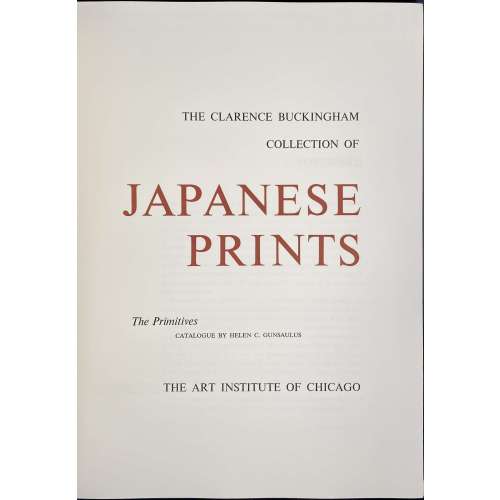 Two volumes, each bound in red cloth with gilt lettering to spine, black endpapers, TEG, and matching red cloth slipcases with black lettering to front. Vol. 1: The Clarence Buckingham collection of Japanese prints: The Primitives / Catalogue by Helen C. Gunsaulus. — [Chicago]: Art Institute of Chicago, 1955. Pagination: 1st leaf blank, 2nd leaf half-title, verso blank, [i, ii] – t.p. in red and black, copyright to verso, iii-vi, [vii] faux-title “The catalogue”, 1-284 [285] colophon, limitation: 500 numbered copies, this is № 476. Title-page: THE CLARENCE BUCKINGHAM | COLLECTION OF | JAPANESE PRINTS | The Primitives | CATALOGUE BY HELEN C. GUNSAULUS | THE ART INSTITUTE OF CHICAGO || Vol. 2: The Clarence Buckingham collection of Japanese prints: Volume 2 / Catalogue by Margaret O. Gentles. — [Chicago]: Art Institute of Chicago, 1965. Pagination: 1st leaf blank, 2nd leaf half-title, verso blank, [i, ii] – t.p. in red and black, copyright to verso, iii-vi, [vii] faux-title “The catalogue”,1-307 [2] blank/ colophon, limitation: 1000 copies (unnumbered). Title-page: VOLUME II | THE CLARENCE BUCKINGHAM | COLLECTION OF | JAPANESE PRINTS | Harunobu, Koryūsai, Shigemasa, their followers and contemporaries | Catalogue by Margaret O. Gentles | THE ART INSTITUTE OF CHICAGO 1965 || Contributors: Clarence Buckingham (American, 1854 – 1913) Helen C. Gunsaulus (American, 1886 – 1954) Margaret O. Gentles (American, 1905 – 1969)
Two volumes, each bound in red cloth with gilt lettering to spine, black endpapers, TEG, and matching red cloth slipcases with black lettering to front. Vol. 1: The Clarence Buckingham collection of Japanese prints: The Primitives / Catalogue by Helen C. Gunsaulus. — [Chicago]: Art Institute of Chicago, 1955. Pagination: 1st leaf blank, 2nd leaf half-title, verso blank, [i, ii] – t.p. in red and black, copyright to verso, iii-vi, [vii] faux-title “The catalogue”, 1-284 [285] colophon, limitation: 500 numbered copies, this is № 476. Title-page: THE CLARENCE BUCKINGHAM | COLLECTION OF | JAPANESE PRINTS | The Primitives | CATALOGUE BY HELEN C. GUNSAULUS | THE ART INSTITUTE OF CHICAGO || Vol. 2: The Clarence Buckingham collection of Japanese prints: Volume 2 / Catalogue by Margaret O. Gentles. — [Chicago]: Art Institute of Chicago, 1965. Pagination: 1st leaf blank, 2nd leaf half-title, verso blank, [i, ii] – t.p. in red and black, copyright to verso, iii-vi, [vii] faux-title “The catalogue”,1-307 [2] blank/ colophon, limitation: 1000 copies (unnumbered). Title-page: VOLUME II | THE CLARENCE BUCKINGHAM | COLLECTION OF | JAPANESE PRINTS | Harunobu, Koryūsai, Shigemasa, their followers and contemporaries | Catalogue by Margaret O. Gentles | THE ART INSTITUTE OF CHICAGO 1965 || Contributors: Clarence Buckingham (American, 1854 – 1913) Helen C. Gunsaulus (American, 1886 – 1954) Margaret O. Gentles (American, 1905 – 1969) -
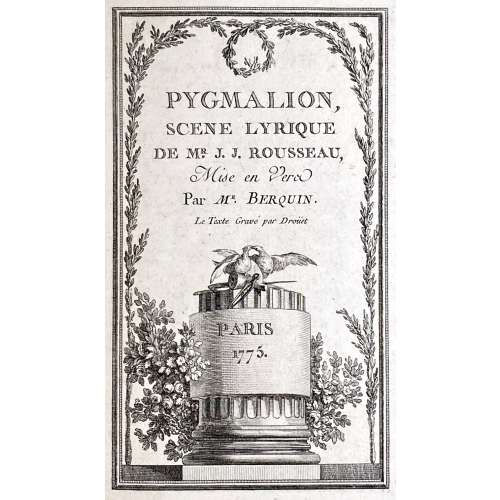 One volume, 22.8 x 15.5 cm, bound in full mottled calf, gilt floral frames to covers, raised bands and gilt fleurons to spine, printed on laid paper. Regarding Pygmalion, scène lyrique see: Wekipedia. Collation: Free endpaper and two blank flyleaves, [2] engraved title, [2] préface, 1-18 (Pygmalion), [2] f.t.p., [1] 2-8 (Idylle), two blank flyleaves and free endpaper; 20 leaves total, adorned with 7 headpieces and 1 tailpiece engraved by Nicolas de Launay, Nicolas Ponce and Charles Etienne Gaucher after Jean Michel Moreau the Younger and Clément Pierre Marillier; text engraved by Droüet. Title-page: PYGMALION, | SCENE LYRIQUE | DE MR. J. J. ROUSSEAU, | Mise en Vers | par MR. Berquin. | Le Text Gravé par Droüet | PARIS | 1775. || (on a column under two kissing doves and sculptor’s tools). Faux t.p.: IDYLLE | Par MR. Berquin. | — | Eructavit cor meum verbum bonum ; | dico ego opera mea regi. | Psalm. 44. | — || (in rules). Catalogue raisonné: Cohen-DeRicci 141 ; Lewine 55. Ref.: MFA (Boston); MET (NY); Yale University Library. Contributors: Artists: Jean-Michel Moreau le Jeune (French, 1741–1814) Clément Pierre Marillier (French, 1740–1808) Engravers: Nicolas Delaunay (French, 1739–1792) Charles-Étienne Gaucher (French, 1741–1804) Nicholas Ponce (French, 1746–1831) Droüet (French, 18th century) Authors: Arnaud Berquin (French, 1747–1791) Jean-Jacques Rousseau (French, 1712–1778)
One volume, 22.8 x 15.5 cm, bound in full mottled calf, gilt floral frames to covers, raised bands and gilt fleurons to spine, printed on laid paper. Regarding Pygmalion, scène lyrique see: Wekipedia. Collation: Free endpaper and two blank flyleaves, [2] engraved title, [2] préface, 1-18 (Pygmalion), [2] f.t.p., [1] 2-8 (Idylle), two blank flyleaves and free endpaper; 20 leaves total, adorned with 7 headpieces and 1 tailpiece engraved by Nicolas de Launay, Nicolas Ponce and Charles Etienne Gaucher after Jean Michel Moreau the Younger and Clément Pierre Marillier; text engraved by Droüet. Title-page: PYGMALION, | SCENE LYRIQUE | DE MR. J. J. ROUSSEAU, | Mise en Vers | par MR. Berquin. | Le Text Gravé par Droüet | PARIS | 1775. || (on a column under two kissing doves and sculptor’s tools). Faux t.p.: IDYLLE | Par MR. Berquin. | — | Eructavit cor meum verbum bonum ; | dico ego opera mea regi. | Psalm. 44. | — || (in rules). Catalogue raisonné: Cohen-DeRicci 141 ; Lewine 55. Ref.: MFA (Boston); MET (NY); Yale University Library. Contributors: Artists: Jean-Michel Moreau le Jeune (French, 1741–1814) Clément Pierre Marillier (French, 1740–1808) Engravers: Nicolas Delaunay (French, 1739–1792) Charles-Étienne Gaucher (French, 1741–1804) Nicholas Ponce (French, 1746–1831) Droüet (French, 18th century) Authors: Arnaud Berquin (French, 1747–1791) Jean-Jacques Rousseau (French, 1712–1778) -
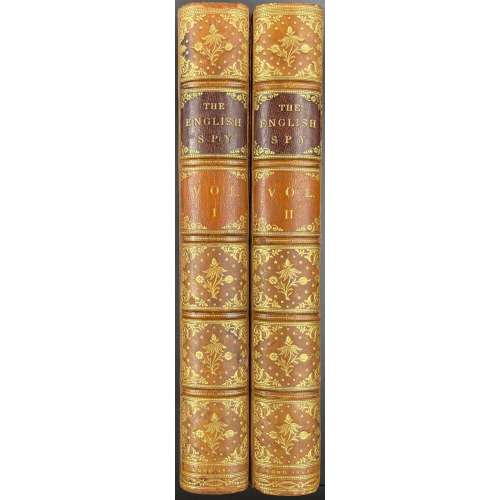 Two volumes 23.2 x 15.6 cm, uniformly bound in full polished calf by Riviere and Son (signed on fep verso), boards with triple gilt fillet border, spine with raised bands, gilt in compartments, gilt-lettered labels; dark blue endpapers, armorial bookplate of William Jennings with the motto “Honor Virtutis Premium” to front pastedown. Vol. 1: THE | ENGLISH SPY: | An Original Work | CHARACTERISTIC, SATIRICAL, AND | HUMOROUS. | COMPRISING | SCENES AND SKETCHES IN EVERY RANK OF SOCIETY, | BEING | PORTRAITS | OF THE | Illustrious, Eminent, Eccentric, and Notorious. | DRAWN FROM THE LIFE | BY BERNARD BLACKMANTLE. | THE ILLUSTRATIONS | DESIGNED BY | ROBERT CRUIKSHANK. | {vignette w/inscription: ‘By Frolic, Mirth, and Fancy gay, | Old Father Time is borne away.’ | — | LONDON : | PUBLISHED BY SHERWOOD, JONES, AND CO. | PATERNOSTER-ROW. | – | 1825. || Collation: [a]8 b4 B-H8 I4 K2 L-Z8 2A-2E8 2F3; total 221 leaves Pagination: [i-iii] iv-xxiii [xxiv] [1-3] 4-417 [418]; total 442 pages. Illustrations: 35 coloured plates, 1 uncoloured plate, and 29 woodcuts in text, incl vignette on title, all but four by Robert Cruikshank, 1 by G. M.B rightly (p. 335), 1 by T. Wageman (p. 413), and 2 by T. Rowlandson (pp. 411 and 416) Vol. 2: THE | ENGLISH SPY: | An Original Work | CHARACTERISTIC, SATIRICAL, AND | HUMOROUS. | COMPRISING | SCENES AND SKETCHES IN EVERY RANK OF SOCIETY, | BEING | PORTRAITS | OF THE | Illustrious, Eminent, Eccentric, and Notorious. | DRAWN FROM THE LIFE | BY BERNARD BLACKMANTLE. | THE ILLUSTRATIONS | DESIGNED BY | ROBERT CRUIKSHANK. | — | VOL. II. | — | {vignette w/inscription: ‘By Frolic, Mirth, and Fancy gay, | Old Father Time is borne away.’ | — | LONDON : | PUBLISHED BY SHERWOOD, GILBERT, AND PIPER, | PATERNOSTER-ROW. | – | 1826. || Collation: [A]-Z8 2A-2C8; total 208 leaves. [i-iii] iv-xv [xvi] [1-3] 4-399 [400]; total 416 pages. Illustrations: 36 coloured plates and 25 woodcuts in text. Catalogue raisonné: Martin-Hardie pp. 191-2; Tooley pp. 266-9; Abbey 325, pp.272-4 (see reflections regarding the ‘first issue’). Contributors: Charles Molloy Westmacott (British, c. 1788 – 1868) – author. Isaac Robert Cruikshank (British, 1789 – 1856) – artist, engraver. G. M. Brightly (British, fl. 1809 – 1827) – artist, engraver. Thomas Charles Wageman (British, 1787-1868) – artist, engraver Thomas Rowlandson (British, 1757 – 1827) – artist. Thomas Davison (British, 1794 – 1826) – printer. Sherwood, Jones, and Co. (London) – publisher. Sherwood, Gilbert, and Piper (London) – publisher. William Jennings – provenance
Two volumes 23.2 x 15.6 cm, uniformly bound in full polished calf by Riviere and Son (signed on fep verso), boards with triple gilt fillet border, spine with raised bands, gilt in compartments, gilt-lettered labels; dark blue endpapers, armorial bookplate of William Jennings with the motto “Honor Virtutis Premium” to front pastedown. Vol. 1: THE | ENGLISH SPY: | An Original Work | CHARACTERISTIC, SATIRICAL, AND | HUMOROUS. | COMPRISING | SCENES AND SKETCHES IN EVERY RANK OF SOCIETY, | BEING | PORTRAITS | OF THE | Illustrious, Eminent, Eccentric, and Notorious. | DRAWN FROM THE LIFE | BY BERNARD BLACKMANTLE. | THE ILLUSTRATIONS | DESIGNED BY | ROBERT CRUIKSHANK. | {vignette w/inscription: ‘By Frolic, Mirth, and Fancy gay, | Old Father Time is borne away.’ | — | LONDON : | PUBLISHED BY SHERWOOD, JONES, AND CO. | PATERNOSTER-ROW. | – | 1825. || Collation: [a]8 b4 B-H8 I4 K2 L-Z8 2A-2E8 2F3; total 221 leaves Pagination: [i-iii] iv-xxiii [xxiv] [1-3] 4-417 [418]; total 442 pages. Illustrations: 35 coloured plates, 1 uncoloured plate, and 29 woodcuts in text, incl vignette on title, all but four by Robert Cruikshank, 1 by G. M.B rightly (p. 335), 1 by T. Wageman (p. 413), and 2 by T. Rowlandson (pp. 411 and 416) Vol. 2: THE | ENGLISH SPY: | An Original Work | CHARACTERISTIC, SATIRICAL, AND | HUMOROUS. | COMPRISING | SCENES AND SKETCHES IN EVERY RANK OF SOCIETY, | BEING | PORTRAITS | OF THE | Illustrious, Eminent, Eccentric, and Notorious. | DRAWN FROM THE LIFE | BY BERNARD BLACKMANTLE. | THE ILLUSTRATIONS | DESIGNED BY | ROBERT CRUIKSHANK. | — | VOL. II. | — | {vignette w/inscription: ‘By Frolic, Mirth, and Fancy gay, | Old Father Time is borne away.’ | — | LONDON : | PUBLISHED BY SHERWOOD, GILBERT, AND PIPER, | PATERNOSTER-ROW. | – | 1826. || Collation: [A]-Z8 2A-2C8; total 208 leaves. [i-iii] iv-xv [xvi] [1-3] 4-399 [400]; total 416 pages. Illustrations: 36 coloured plates and 25 woodcuts in text. Catalogue raisonné: Martin-Hardie pp. 191-2; Tooley pp. 266-9; Abbey 325, pp.272-4 (see reflections regarding the ‘first issue’). Contributors: Charles Molloy Westmacott (British, c. 1788 – 1868) – author. Isaac Robert Cruikshank (British, 1789 – 1856) – artist, engraver. G. M. Brightly (British, fl. 1809 – 1827) – artist, engraver. Thomas Charles Wageman (British, 1787-1868) – artist, engraver Thomas Rowlandson (British, 1757 – 1827) – artist. Thomas Davison (British, 1794 – 1826) – printer. Sherwood, Jones, and Co. (London) – publisher. Sherwood, Gilbert, and Piper (London) – publisher. William Jennings – provenance -
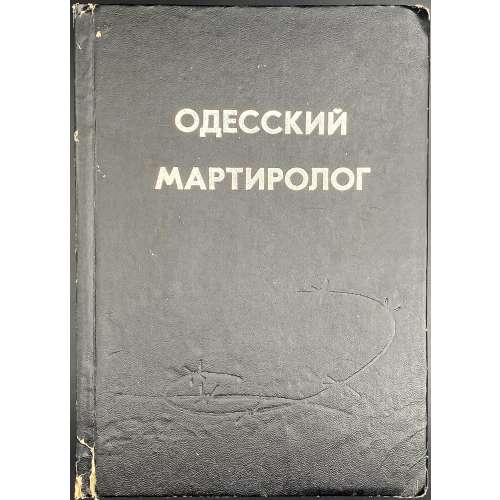 Hardcover volume, 24.5 x 17.5 cm, bound in black buckram with blind barbed wire design and silver lettering to front cover and spine, pp.: [2] 3-750 [2]. Одеський мартиролог: Данi про репресованих Одеси i Одеськоï областi за роки радянськоï влады (Серiя «Одеського Меморiалу») (Том 1) / Уклад.: Л. В. Ковальчук, Г. О. Разумов— Одеса : ОКФА, 1997. Title-page: (in rules) СЕРИЯ «ОДЕССКОГО МЕМОРИАЛА» | ОДЕССКИЙ | МАРТИРОЛОГ | ТОМ 1 | Одесса | ОКФА | 1997 || ISBN: 966-571-065-9 Ковальчук, Лидия Всеволодовна Разумов, Георгий Александрович
Hardcover volume, 24.5 x 17.5 cm, bound in black buckram with blind barbed wire design and silver lettering to front cover and spine, pp.: [2] 3-750 [2]. Одеський мартиролог: Данi про репресованих Одеси i Одеськоï областi за роки радянськоï влады (Серiя «Одеського Меморiалу») (Том 1) / Уклад.: Л. В. Ковальчук, Г. О. Разумов— Одеса : ОКФА, 1997. Title-page: (in rules) СЕРИЯ «ОДЕССКОГО МЕМОРИАЛА» | ОДЕССКИЙ | МАРТИРОЛОГ | ТОМ 1 | Одесса | ОКФА | 1997 || ISBN: 966-571-065-9 Ковальчук, Лидия Всеволодовна Разумов, Георгий Александрович -
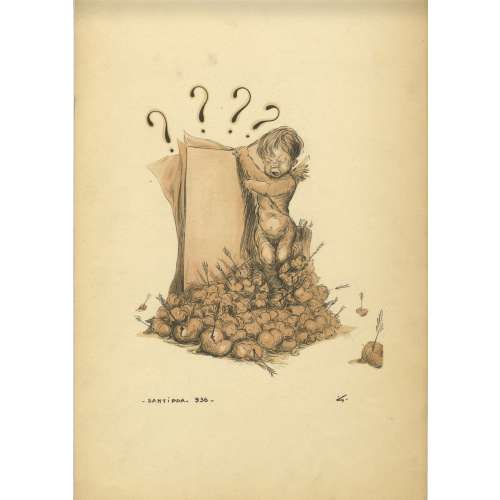 Publisher's flapped folder of black velvet paper with dark green embossed vignette, 494 x 325 mm, with a pink limitation label inside the front cover and a printed spade with 'FIN" inside the back cover; a set of 13 lithographs signed Santippa, 936; 480 x 310 mm each, twelve in black and one (title) coloured with sanguine. Limited edition of 250 copies, 1-100 printed on Hollande and 150 on Japon; this is copy № 127.
Publisher's flapped folder of black velvet paper with dark green embossed vignette, 494 x 325 mm, with a pink limitation label inside the front cover and a printed spade with 'FIN" inside the back cover; a set of 13 lithographs signed Santippa, 936; 480 x 310 mm each, twelve in black and one (title) coloured with sanguine. Limited edition of 250 copies, 1-100 printed on Hollande and 150 on Japon; this is copy № 127.Titles: Rêverie, Gaspillage, Exagération, Simplicité, Gourmandise, Abondance, Violence, Fantaisie, Faiblesse, Curiosité, Obligeance, Surprise.
Contributors:Gaston Hoffmann [Santippa] (French, 1883 – 1977)
-
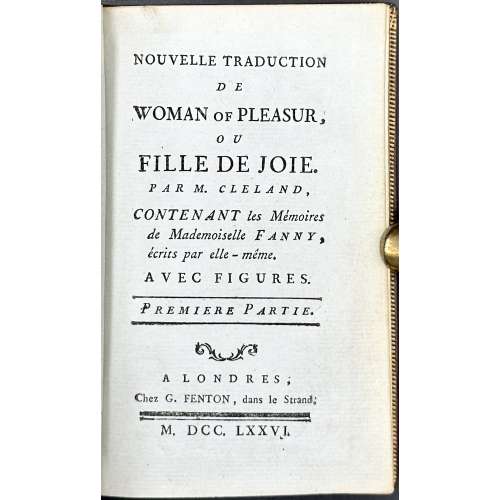 Hardcover volume, collated 18mo, 130 x 85 mm (2 parts in one). Contemporary burgundy morocco outlined with gilt triple fillet, flat spine gilt in compartments, brown morocco label gilt, all edges gilt, gilt dentelle, text printed on slightly blue laid paper with illegible watermark; dark blue endpapers, Tony Fekete (T. F.) bookplate by Wahorn to front pastedown. Frontispiece and 14 engraved plates by Elluin after Borel, with guard tissue. Graphite ms to h.t.: "Figures de Borrel. | Gravées pr. Elluin." Title-page: NOUVELLE TRADUCTION | DE | WOMAN OF PLEASUR, | OU | FILLE DE JOIE. | PAR M. CLELAND, | CONTENANT les Mémoires | de Mademoiselle FANNY, | écrits par elle – même. | AVEC FIGURES | — | PREMIERE (SECONDE) PARTIE. | — | ~ | A LONDRES; | Chez G. FENTON, dans le Strand; | — | M. DCC. LXXVI. || Collation: 18mo throughout A-O12/6, total 126 leaves plus 15 plates, incl. frontispiece. Pagination: separate for each part [1-5] 6-119 [120 blank], [1-3] 4-132, total 252 pages. Provenance: Tony Fekete (Christie’s 2014, № 54, p. 37; Price realized GBP 11,875): “[CLELAND, John (1709-1789).] Nouvelle traduction de Woman of Pleasur [sic] ou Fille de Joie. Contenant les Mémoires de Mademoiselle Fanny, écrits par elle-même. London [but Paris]: G. Fenton [Cazin], 1776. 2 volumes in one, duodecimo (128 x 80 mm). Printed on blue tinted paper. Frontispiece and 14 engraved plates on thick white paper by Elluin after Borel. (Short tear repaired in the margin of one plate, another plate with a faint dampstain touching the facing leaf of text.) Contemporary burgundy morocco, flat spine gilt in compartments, morocco label gilt, covers with a gilt triple fillet border, gilt edges, blue endpapers. THE MOST BEAUTIFUL 18TH-CENTURY ILLUSTRATED EDITION OF THIS CELEBRATED EROTIC NOVEL. An excellent copy bound in contemporary morocco. It is the second translation into French, but the first to include the exquisite plates by Elluin after Borel. These are some of the best illustrations by this remarkable partnership responsible for a number of important 18th-century libertine texts. Cohen-DeRicci 242-3; Dutel A-407 ; Gay-Lemonnyer II, 304; Pia Enfer, 915.” Catalogue raisonné: Dutel (I) A-407, p. 134; Cohen-DeRicci 242-3; Fekete (Christie's) 54, p. 37. Contributors: John Cleland (British, c. 1709 – 1789). François-Rolland Elluin (French, 1745 – c. 1822) Antoine Borel (French, 1743 – 1810) Hubert-Martin Cazin (French, 1724 – 1795) András Wahorn (Hungarian, b. 1953) Fekete, Tony Laszlo (Hungarian, b. 1972)
Hardcover volume, collated 18mo, 130 x 85 mm (2 parts in one). Contemporary burgundy morocco outlined with gilt triple fillet, flat spine gilt in compartments, brown morocco label gilt, all edges gilt, gilt dentelle, text printed on slightly blue laid paper with illegible watermark; dark blue endpapers, Tony Fekete (T. F.) bookplate by Wahorn to front pastedown. Frontispiece and 14 engraved plates by Elluin after Borel, with guard tissue. Graphite ms to h.t.: "Figures de Borrel. | Gravées pr. Elluin." Title-page: NOUVELLE TRADUCTION | DE | WOMAN OF PLEASUR, | OU | FILLE DE JOIE. | PAR M. CLELAND, | CONTENANT les Mémoires | de Mademoiselle FANNY, | écrits par elle – même. | AVEC FIGURES | — | PREMIERE (SECONDE) PARTIE. | — | ~ | A LONDRES; | Chez G. FENTON, dans le Strand; | — | M. DCC. LXXVI. || Collation: 18mo throughout A-O12/6, total 126 leaves plus 15 plates, incl. frontispiece. Pagination: separate for each part [1-5] 6-119 [120 blank], [1-3] 4-132, total 252 pages. Provenance: Tony Fekete (Christie’s 2014, № 54, p. 37; Price realized GBP 11,875): “[CLELAND, John (1709-1789).] Nouvelle traduction de Woman of Pleasur [sic] ou Fille de Joie. Contenant les Mémoires de Mademoiselle Fanny, écrits par elle-même. London [but Paris]: G. Fenton [Cazin], 1776. 2 volumes in one, duodecimo (128 x 80 mm). Printed on blue tinted paper. Frontispiece and 14 engraved plates on thick white paper by Elluin after Borel. (Short tear repaired in the margin of one plate, another plate with a faint dampstain touching the facing leaf of text.) Contemporary burgundy morocco, flat spine gilt in compartments, morocco label gilt, covers with a gilt triple fillet border, gilt edges, blue endpapers. THE MOST BEAUTIFUL 18TH-CENTURY ILLUSTRATED EDITION OF THIS CELEBRATED EROTIC NOVEL. An excellent copy bound in contemporary morocco. It is the second translation into French, but the first to include the exquisite plates by Elluin after Borel. These are some of the best illustrations by this remarkable partnership responsible for a number of important 18th-century libertine texts. Cohen-DeRicci 242-3; Dutel A-407 ; Gay-Lemonnyer II, 304; Pia Enfer, 915.” Catalogue raisonné: Dutel (I) A-407, p. 134; Cohen-DeRicci 242-3; Fekete (Christie's) 54, p. 37. Contributors: John Cleland (British, c. 1709 – 1789). François-Rolland Elluin (French, 1745 – c. 1822) Antoine Borel (French, 1743 – 1810) Hubert-Martin Cazin (French, 1724 – 1795) András Wahorn (Hungarian, b. 1953) Fekete, Tony Laszlo (Hungarian, b. 1972)


